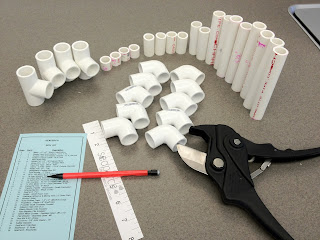This
passed Friday April 20th, the team met up in lab as scheduled and
worked on building the sea perch, which was handed by instructor that same
day.
Since the kit came with the white (control box _ the white thing ) it was advised to follow the M.I.T step by step instructions
Since the kit came with the white (control box _ the white thing ) it was advised to follow the M.I.T step by step instructions
but we also looked at
for extra help building
the control box.
We started cutting all the PVC pieces
into smaller sizes as directed in the manual
Two pieces – 2 1/2” (6.4 cm) long
Two pieces – 4” (10.2 cm) long
Two pieces – 4 1/2” (11.4 cm) long
Four pieces – 1 1/2” (3.8 cm) long
Four pieces – 5” or (12.7 cm) long
Four pieces – 3/4" long
Next we drilled 1/4" drain holes
with a drill bit
When we had everything we assembled the
frame of the sea perch that looked like this:
We also started working on the control
box but time did not allow us to finish so we arranged to meet before the next
lab to work on that and discuss about the sensors.
We would like to include a camera with a flashlight on the body as well to help us move the sea perch better in deep water.
We would like to include a camera with a flashlight on the body as well to help us move the sea perch better in deep water.
The team's goal is to collect data concerning the temperature, pH levels, and the clearity of the river water , and is also researching the different sensors necessary to do so.


